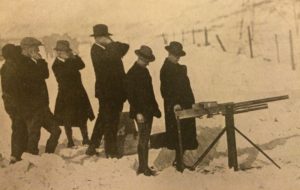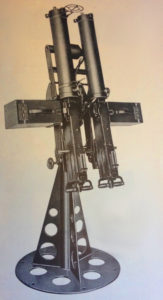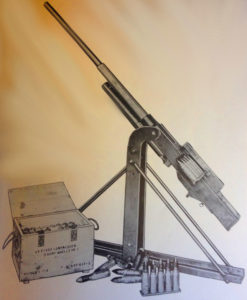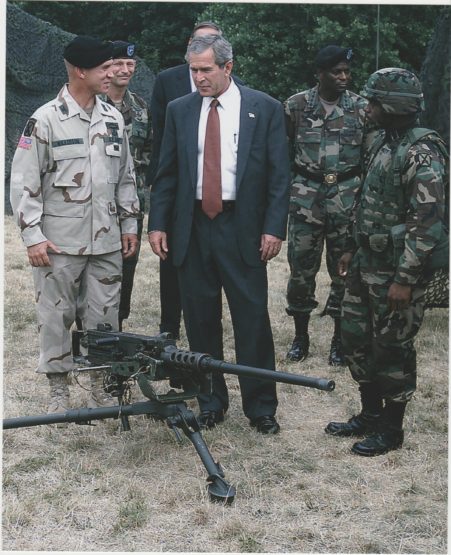Browning Guns in Times of National Defense
It is at the outset of the World War I (1914-1918) that the machine gun literally gained popularity as a defensive and offensive weapon necessary in the armaments of nations. In their strategic attempt to world domination, the Germans had spent years building up vast supplies of the Maxim type gun which, in order to obtain sufficient durability, had to be assembled with such heavy components so as to pose difficulty in the matter of mobility and transport under combat conditions.
The Allied Armies possessed almost negligible and woefully inadequate machine guns to meet this threat. How close the Germans came to succeeding in their endeavored triumph! What a case of how about the long, persistent endeavors of the German Armorers, in the hands of heartless aggressors, came to changing the whole part of human life and freedom, may not, even now, be completely acknowledged by many. With their eyes opened by occasions, the countries opposing the Central Powers now set forth wild endeavors to secure automatic rifles. What were around then thought to be huge amounts of any accessible sorts of guns were requested in this nation and, by virtue of the limited time, the expense of building plants, and training work were astounding.
 In any case, the American small arms industry was starting to stir up itself and the long torpid assumption for sufficient readiness in this nation was stimulated. The Armed Forces of the United States were calling for quality guns than were then accessible and the month of May 1917, was set with the objective of conducting aggressive tests. John M. Browning expected his part of the assignment and quickly gave the issue his consideration. When the trial time came, Mr. Browning purchased two new guns to the competition. He named the first one the Browning Heavy Water-cooled Machine Gun, which weighs around 37 pounds with the water coat filled. Belt bolstered and recoiled operated, it is his enhanced version of the recoil-operated machine gun designed several years back and mentioned previously herein.
In any case, the American small arms industry was starting to stir up itself and the long torpid assumption for sufficient readiness in this nation was stimulated. The Armed Forces of the United States were calling for quality guns than were then accessible and the month of May 1917, was set with the objective of conducting aggressive tests. John M. Browning expected his part of the assignment and quickly gave the issue his consideration. When the trial time came, Mr. Browning purchased two new guns to the competition. He named the first one the Browning Heavy Water-cooled Machine Gun, which weighs around 37 pounds with the water coat filled. Belt bolstered and recoiled operated, it is his enhanced version of the recoil-operated machine gun designed several years back and mentioned previously herein.
The second one is called the Browning Machine Rifle, (later known as the “Light Browning”, and now known as the “Browning Automatic Rifle” or “B.A.R.”). This is an operated, air-cooled, programmed rifle that may be shot from the hip or shoulder. It can be discharged one shot at once or changed over in a split second to shooting full automatically by basically moving a small lever. It comprises 20-round magazine which can be emptied by actual firing in 21/2 seconds. The empty magazine can then be replaced with a loaded magazine in the same time difference. The cyclic firing rate is more than 600 rounds for each moment. One of Mr. Browning’s machine guns finished the 20,000 round tests without a breakdown in the Government tests. This astonishing performance was met with the instant endorsement of the specialists in control. Together with his assistants Mr. Browning’s chose to test the gun further and kept shooting until they had put about 40,000 rounds through the firearm without any failure.
In order to check the phenomenal performance of the first gun, another of these same guns was put through the 20,000 round tests. It was continuously fired for 48 minutes and 12 seconds in finishing the test, and was so fruitful in this, and other performances that its mechanism is presently utilized in a few diverse sorts of water, and air cooled automatic guns. The firing rate of these automatic guns can be adjusted to the distinctive modern fighting units and can be regulated on a need basis.
A notable superior quality of these guns was the simplicity of design. It was so simple that machine gun operators in the Army were able to dismantle and assemble the Browning Machine Guns while blind-folded. This simplicity was valuable to the Government since it was made after the conclusion of the tests by the five Army officers board and the two civilians who were appointed by the war secretary to analyze the problem. It possible to get the production quickly—a most important consideration at that time.
The period between May 1917, and the marking of the Armistice, the following year, more than 48,000 of these guns were dispatched abroad to some place in France. According to the book, “America’s Munitions of 1917-1918” by Honorable Benedict Crowell, Assistant War Secretary, at the request of the Secretary of War, so that: “All the general population ought to be given a chance to comprehend what has been done for their benefit in weapons productions” the following data gives us some thought on how production of Browning Water-cooled Machine Guns and Browning Machine Rifles advanced. “The day by day most extreme creation of Browning Rifles achieved 706 preceding our assembling efforts were abruptly halted and that of Browning Heavy Machine Guns 575.” Another very interesting quotation from Mr. Crow-ell’s book portrays what is demanded of both men and guns during the war. “Both types of Browning guns proved to be unqualified successes in actual battle, as numerous reports of our Ordnance officers overseas indicated.
 In addition to carrying historical information of interest to those following our machine-gun development, the following report from an officer is typical of numerous other official descriptions of these weapons in battle use: ‘The guns (heavy Brownings) went into the front line for the first time on the night of September 13. Until the advance, starting September 26, the sector was quiet, and the guns were practically not used at all. The guns were used on several occasions for an overhead fire in the action which followed, one company firing 10,000 rounds per gun into the wood in which there were enemy machine-gun nests, at a range of 2,000 meters.
In addition to carrying historical information of interest to those following our machine-gun development, the following report from an officer is typical of numerous other official descriptions of these weapons in battle use: ‘The guns (heavy Brownings) went into the front line for the first time on the night of September 13. Until the advance, starting September 26, the sector was quiet, and the guns were practically not used at all. The guns were used on several occasions for an overhead fire in the action which followed, one company firing 10,000 rounds per gun into the wood in which there were enemy machine-gun nests, at a range of 2,000 meters.
The guns performed well, although on account of rain and mud the conditions were extremely unfavorable for machine guns. According to the Machine-gun officer’s report, even though covered with rust and using muddy ammunition, during the engagement the guns came up to the fullest expectations and, they functioned whenever called upon to do so. 17 guns from one company were sent in for my inspection after the division had been relieved.
One of these had been struck by shrapnel, which punctured the water coat. The greater parts of the firearms were totally covered with mud and rust on the outside although however the instrument was genuinely clean. Without touching them or cleaning them in any way, except to run a rod through the bore, a 250 rounds belt was fired from each gun without a solitary stoppage of any sort. From the experiment in this division, ‘it can be concluded that the gun in its functioning and operation, when taken care of by men in the field, is a success.’ “The Browning Automatic Rifles were also highly praised by our officers who had to use them. Although these guns received hard usage, being on the front for days at a time in the rain and when the gunners had little opportunity to clean them, they invariably functioned well.” After the United States Government formally received the guns and the enormous production schedules were under way, a meeting occurred between the Government delegates and J. M and M. S. Browning.
2016-06-19 11.23.57On the use of all of the Browning patents, the Government delegates proposed a certain sum of money as remuneration including the .45 caliber automatic pistol. Without hesitation or quibble, the Browning’s accepted the Government proposal which resulted to less than one-tenth of the amounts usually paid as royalty on such guns. Later the War Secretary wrote Mr. Browning the following letter.
WAR DEPARTMENT
WASHINGTON
November 13, 1917.
My dear Mr. Browning: I have learned from Major Little of the patriotic and generous attitude taken by you in the negotiations for the use of your patents of light and heavy machine guns in this emergency, and beg to express my appreciation of it. You have performed, as you must realize, a very distinct service to the country in these inventions, and contributed to the strength and effectiveness of our armies. You have added to that service by the attitude you have taken in the financial arrangements necessary to make your inventions available to the Government.
Cordially yours,
NEWTON D. BAKER, Secretary of War.
The war was over; John M. Browning kept at work. “There will come another war,” he immovably asserted, “and the skies will swarm with warriors. This nation must by any chance not be gotten without the exceptionally most recent type weapons and again pay the terrific cost of attempting to do, in a few months, what different countries had spent long patient years in doing! By then he had made an air-cooled model of the recoil-operated machine gun, weighing just 22 pounds, and with firing rate expanded to seven hundred shots per minute.
 This was the first main gun in this nation to be effectively fixed before the pilot of a pursuit plane to enable the pilot look along its sights and point the gun by moving his ship; to do this the shooting mechanism of the gun was synchronized with the engine of the plane so that a stream of shots could be discharged through the way of the spinning propeller without hitting it. But planes and tanks could be armored to avoid the normal .30 bore bullets! Browning made a .50 caliber automatic gun on the same mechanical principle as the .30, however shooting a progression of bullets one-half inch in the distance across at the rate of five hundred every minute.
This was the first main gun in this nation to be effectively fixed before the pilot of a pursuit plane to enable the pilot look along its sights and point the gun by moving his ship; to do this the shooting mechanism of the gun was synchronized with the engine of the plane so that a stream of shots could be discharged through the way of the spinning propeller without hitting it. But planes and tanks could be armored to avoid the normal .30 bore bullets! Browning made a .50 caliber automatic gun on the same mechanical principle as the .30, however shooting a progression of bullets one-half inch in the distance across at the rate of five hundred every minute.
Browning then made models of three different 37 M/M (one and one-half inch caliber) automatic cannons at the request of progressive-minded officers of the U. S. Ordnance Department. At his experimental shop in Ogden, the first model, made fired projectiles weighing more than one pound, with a velocity of about 1,400 feet per second, at the rate of more than one hundred fifty per minute. He went back to the factory to make the second and third models, which fired heavier shells at greater velocities. Interest in military weapons then became apathetic.
Finances were reducing for development work, and the feeling throughout the nation turned out to be by and large really threatening towards anybody in any capacity associated with military arms. A standout amongst the most magnificent machine gun factories in the world, Colt’s, changed its efforts towards, electrical gear, dish-clothes washers, and plastics to keep its wheels turning and work utilized. John M. Browning’s most recent models were filled away, yet were bound to have influence later, with retaliation.

